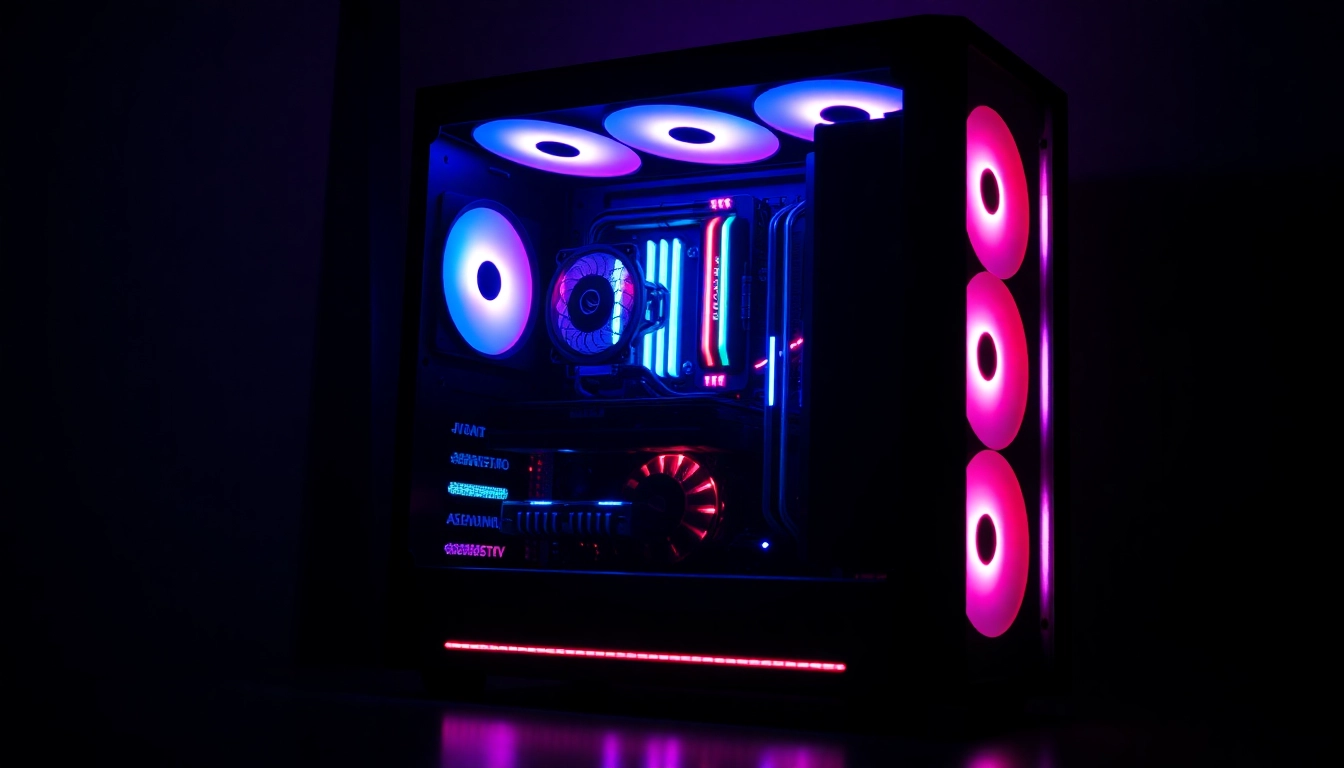1. Understanding Gaming PC Cases
1.1 What is a gaming pc case?
A gaming PC case, also known as a computer chassis, is fundamentally the shell that houses all the vital components of a gaming computer. It provides structural integrity while protecting delicate hardware from damage. Beyond its protective role, a gaming PC case allows for optimal air circulation, enhancing cooling efficiency, and comes with various designs and configurations to suit aesthetic preferences and functional needs. A well-chosen gaming pc case can make a substantial difference in the overall performance and longevity of the components housed within it.
1.2 Types of gaming pc cases
Gaming PC cases come in various shapes and sizes, tailored to different build preferences and space requirements. Primarily, there are three main types:
- Full Tower Cases: Ideal for high-end builds, these cases accommodate multiple graphics cards and extensive cooling options. They provide ample room for future upgrades and extraordinary cooling configurations.
- Mid Tower Cases: The most popular choice among gamers, mid tower cases can fit a decent number of components while still being compact enough for most desks. They balance size and accessibility well.
- Mini Tower Cases: These are great for small form factor (SFF) builds where space is at a premium. Although limited in expansion options, mini towers can still provide excellent aesthetics and cooling.
1.3 Importance of airflow in gaming pc cases
Airflow is a critical factor in the design of any gaming PC case. Efficient airflow ensures that the CPU, GPU, and other components remain adequately cooled, reducing the risk of overheating during intense gaming sessions. Most gaming cases include multiple fan mounting options and even support custom liquid cooling systems. Key airflow considerations include:
- Fan Placement: Strategic placement of intake and exhaust fans can promote optimal airflow across components.
- Case Ventilation: Good ventilation design allows hotter air to escape while cooler air is drawn in, maintaining balanced temperatures.
- Dust Filters: Integral for keeping the interior clean, these filters prevent dust accumulation on essential components, enhancing performance and longevity.
2. Features to Look for in a Gaming PC Case
2.1 Size and compatibility considerations
When selecting a gaming PC case, size is paramount—confirm that the case can accommodate your motherboard size (ATX, Micro-ATX, Mini-ITX) and any future upgrades you may plan. Additional considerations include:
- GPU Length: Ensure that there’s enough room for your graphics card, especially as some high-performance GPUs are longer than average.
- Cooling Solutions: Check if the case supports aftermarket cooling solutions, allowing for better thermal performance.
- Drive Bays: Consider how many SSDs and HDDs you plan to install and whether the case provides adequate bays without compromising airflow.
2.2 Cable management options
Good cable management not only improves the aesthetic of your build but also enhances airflow by minimizing clutter. Look for cases that offer:
- Routing Holes: These allow you to hide cables behind the motherboard tray for a cleaner look.
- Velcro Straps and Zip Ties: Many cases come equipped with these for organizing cables effectively.
- Removable Drive Cages: These add flexibility in managing cables, especially in cases with many components.
2.3 Aesthetic design vs. functionality
Aesthetics play a role in choosing a gaming PC case, especially for gamers who like to showcase their hardware setups. While visualization is vital, functionality should not be compromised. Prospective buyers should weigh:
- RGB Lighting: Many gaming cases incorporate RGB lighting systems; however, ensure that they are compatible with your motherboard and can be easily customized.
- Tempered Glass Panels: While they provide a sleek look, consider their susceptibility to scratches and fingerprints.
- Build Materials: Look for cases constructed from high-quality materials that not only appear sleek but also promote durability and cooling efficiency.
3. Top Gaming PC Case Brands and Models
3.1 Leading brands: Corsair, NZXT, and Lian Li
Several brands dominate the gaming PC case market due to their innovation and performance. Three such brands are:
- Corsair: Known for high-quality cooling and vast options, Corsair cases frequently cater to both aesthetics and functionality. Models like the Corsair 4000D and 5000D range are particularly popular among gamers for their airflow and versatility.
- NZXT: Combining sleek design with functionality, models such as the NZXT H510 and H510i are renowned for their cable management options and compact sizing.
- Lian Li: Esteemed for their all-aluminum cases, Lian Li’s designs offer exceptional durability and aesthetics, especially in the Lian Li PC-O11 series.
3.2 Comparison of budget vs. premium gaming pc cases
When venturing into the world of gaming PC cases, understanding the distinction between budget and premium options is essential. Budget cases can indeed fulfill your basic needs, often including crucial features like enough space for components and basic airflow facilities. However, premium cases typically offer enhanced construction quality, better cooling options, and aesthetic appeal. Here’s a closer look:
- Budget Cases: These often range from $50-$100, providing essential functionality. Common options include brands like Thermaltake and Cooler Master.
- Premium Cases: Priced above $100, these cases typically feature better airflow designs, superior cable management, and customizable lighting solutions, making them favorable for high-end builds.
3.3 User reviews and ratings
Understanding consumer sentiment and experiences can guide your choice significantly. Exploring user reviews on platforms like Amazon or Newegg provides insights into:
- Build Quality: Many users share their hands-on experiences regarding the sturdiness of the materials used.
- Ease of Building: Users often comment on the ease or difficulty of installing components, which is vital information for DIY builders.
- Cooling Performance: Real-world reports of thermal performance can help gauge whether the case lives up to its claims.
4. Building Your Gaming Rig: Choosing the Right Case
4.1 Essential components to fit in a gaming pc case
When constructing a gaming rig, it is essential to ensure adequate space for all components. Common parts include:
- Motherboard: Confirm compatibility with the case you choose, as motherboard sizes can vary.
- CPU Cooler: Depending on your cooler’s height, verify clearance levels to avoid fitting issues.
- Graphics Card: Ensure the selected case can accommodate the length of your GPU.
- Storage Drives: Assess how many SSDs or HDDs you plan to install, ensuring adequate drive bays.
4.2 Tips for setting up a custom water cooling system
Custom water cooling systems are praised for superior cooling and aesthetic appeal. Here are essential tips for setup:
- Select a Suitable Case: Ensure your case supports radiators and has enough space for pumps and reservoirs.
- Gather Necessary Components: Ensure you have all necessary components—radiators, water blocks, pumps, and tubing.
- Follow a Logical Flow: Set up in a manner that ensures coolant flows efficiently from the reservoir to the components and back.
- Leak Testing: Before powering up, perform thorough leak tests to prevent damage to hardware.
4.3 Upgrading your case: When and why?
As technology evolves, upgrading your gaming PC case may be advantageous for several reasons:
- Better Cooling Options: If your current case cannot support modern cooling builds, upgrading can improve thermal performance.
- More Space: As your rig grows, a larger case may provide room for additional components.
- Aesthetic Refresh: Newer cases often feature better designs; upgrading can significantly refresh the look of your gaming setup.
5. Maintenance and Care for Gaming PC Cases
5.1 Cleaning and upkeep best practices
Keeping your gaming PC case clean is vital for optimal performance. Regular maintenance should include:
- Dusting: Use compressed air to blow dust from inside the case, paying special attention to fans and vents.
- Wiping Surfaces: A damp microfiber cloth can clean the exterior without scratching.
- Inspecting Fans: It’s essential to check if fans are working optimally and replace any defective ones.
5.2 Troubleshooting common issues
Common problems with gaming PC cases can often be resolved with a few troubleshooting steps:
- Overheating: If overheating occurs, verify fan functionality, clean dust from components, and ensure sufficient airflow.
- Noisy Operation: Check for loose screws or worn fans, which may cause vibrating noise.
- Connectivity Issues: Ensure that cables are properly routed and seated; intermittent connections can be caused by improperly connected cables.
5.3 Enhancing longevity with proper care
To ensure long-lasting performance from your gaming PC case and its contents:
- Regular Inspections: Periodically check that all components are secure and functioning properly.
- Keep Humidity Levels in Check: Store and use your gaming rig in an environment with controlled humidity to prevent corrosion.
- Component Upgrades: Keep your rig current with adequate upgrades to prevent obsolescence, which can lead to overheating or compatibility issues.



